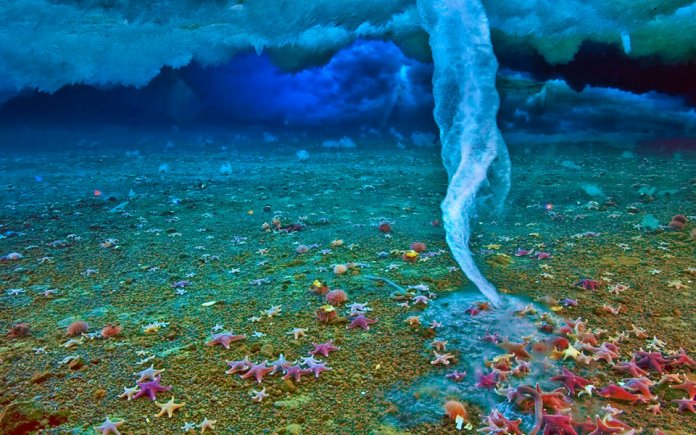Not all people love winter, with its frost, ice, and difficult driving conditions. Indeed, winter can be a dangerous and unpleasant time of the year. But she can also be fantastically beautiful. Grab a cup of hot drink, wrap yourself in a blanket, and we will tell you about the most amazing phenomena that happen in winter.
7. Light poles
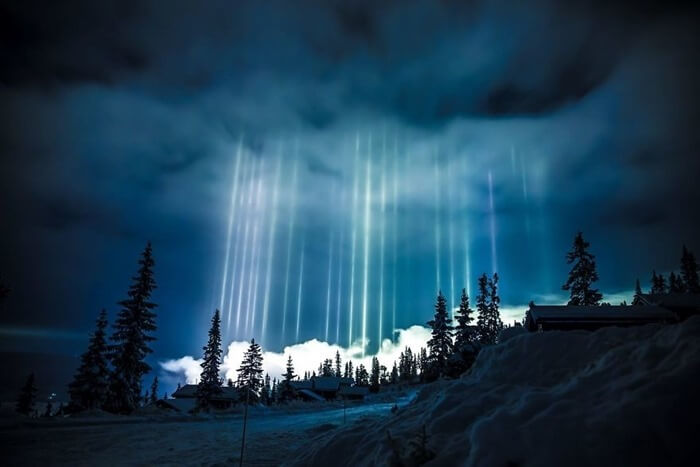
These "lightsabers" as if floating above the surface of the earth can be mistaken for UFOs from afar. On a frosty night, they are a delightful sight that seems to be the work of supernatural forces.
However, science has long known about the existence of pillars of light. They appear when light is reflected from the smallest ice crystals suspended in the air (with a hexagonal cross-section or columnar, depending on the angle of the sun or moon). Such crystals usually appear in high cirrus clouds. However, ice crystals form in the lower layers of the atmosphere during frost. Therefore, pillars of light often appear in winter. And their multicolored hue is due to the lights they reflect.
It is interesting that similar phenomena can occur in sunny weather and with the moon, depending on which light is reflected from the ice crystals.
6. Snow Thunderstorm
This is a meteorological phenomenon, in which during a snowstorm, thunder rumbles and lightning flashes like summer.
According to forecasters, snow thunderstorms occur when cold atmospheric fronts invade warm air mass. The speed of movement of such fronts is, on average, 40 km / h.
When, in an unstable atmosphere, cold air comes into contact with warm air, a sharp temperature drop occurs (up to several tens of degrees at an altitude of several kilometers). Because of this, thunder and lightning occur, and in addition, heavy snowfalls.
A snow thunderstorm is a rather rare event for Russia. She was observed in Novosibirsk, in December 2015, in Novorossiysk in January 2012, in the capital in December 1995 and in the same month in 2011. However, in Murmansk, a snowstorm occurs, on average, once a year.
5. Pancake ice

A strange sight can sometimes be observed in winter: the river is covered with circles that reach up to 3 meters in diameter. These circles look like a round pizza or huge pancakes, but they are not made of dough, but ice up to ten centimeters thick.
Experts say this ice-cold "pizza" is formed when the freezing process is interrupted by ripples, and patches of ice collide and rub together, erasing sharp corners.
These pancakes are most commonly found in Antarctica, but can occur in any large body of water.
4. Hoarfrost
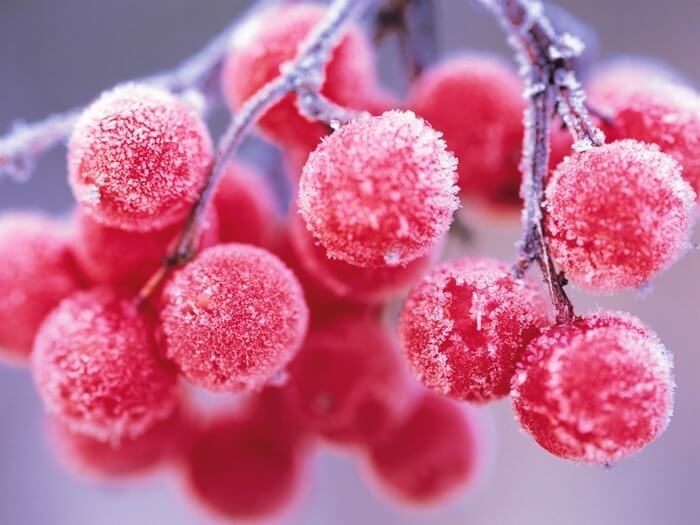 On a cold day, on shrubs and trees, you can see a thin layer of small ice crystals, similar to the beard of Santa Claus.
On a cold day, on shrubs and trees, you can see a thin layer of small ice crystals, similar to the beard of Santa Claus.
Frost is created similarly to dew. At negative temperatures, the contact of water vapor molecules with a branch or other object leads to their transition from a gaseous state to a solid state. This is what causes the appearance of many feathery ice crystals. The more moisture the air contains, the thicker the frost will be.
3. Frozen frogs
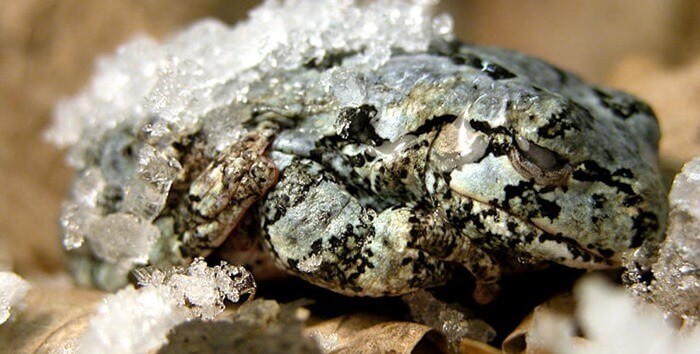
Third place in the top 7 amazing winter natural phenomena went to an ordinary, at first glance, frog. Different animals have physiological characteristics that help them survive in the cold. Bears, for example, hibernate, but the tree frog has an even simpler strategy: it simply freezes.
For the winter, tree frogs look for depressions in the ground. They fill it with leaves and twigs, which provide warmth, burrow into shelter and hibernate. The frog's heart stops beating, organs stop functioning, and the blood freezes.
If we were talking about another living being, then such a freezing would damage the tissues of the body, destroying the fragile structures of cells. Dehydrated cells can no longer function.
The tree frog, on the other hand, avoids this life-threatening dilemma. Before hibernation, a large amount of glucose is produced in her body, which is then transported to cells and acts as an antifreeze.
Urea levels are also increased, which contributes to additional cell protection. While the cells themselves do not freeze, the water freezes in the skin, eyes and muscles, making the frog hard as a stone.
When spring comes, the amphibian thaws without the slightest damage to health.
2. A hole in the sky
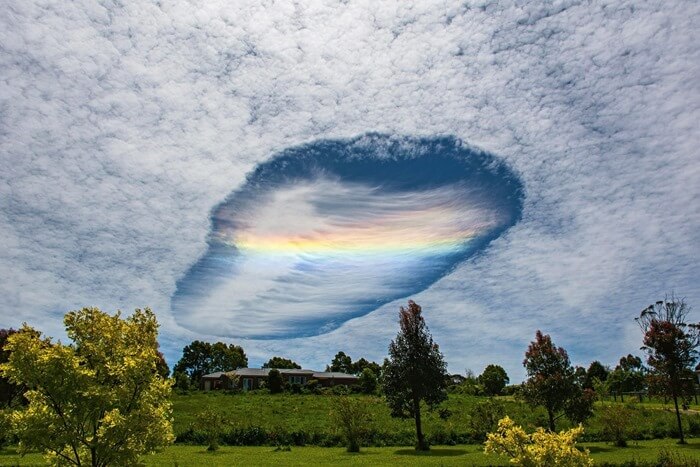
Only in winter can one observe the phenomenon, which in English literature is called Skypunch (and also Fallstreak hole and Hole punch cloud). It seems that the hand of a giant living in the sky reached down and made a hole in the clouds so that you can better see what is happening below.
A similar phenomenon occurs only when the water droplets in the clouds are in a supercooled position. In the absence of freezing nuclei, water droplets can remain in a liquid state at temperatures up to minus 40 degrees Celsius.
When exposed to an external force, some of the water droplets turn into ice and start a chain reaction of freezing and falling down the rest of the droplets. Because of this, a large circle forms in the clouds in a matter of seconds.
Research has confirmed that passing aircraft are responsible for initiating the droplet crystallization process. As planes fly through a cloud, the air cools as it travels through the wings and propeller of the plane.
1. Deadly icicles
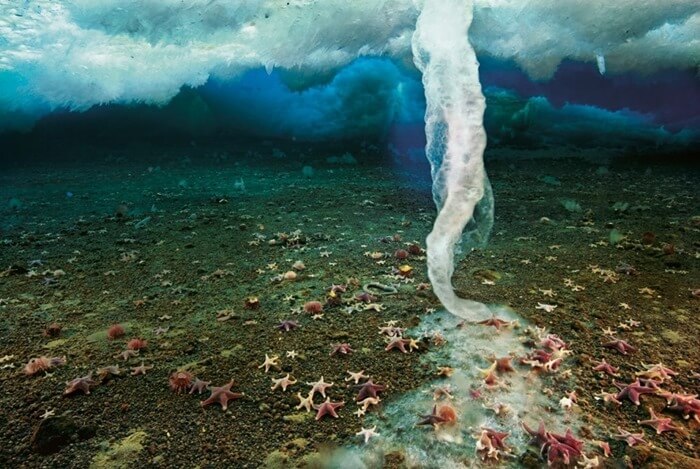
If you thought about an ordinary icicle that can fall on your head and kill, you are wrong. Underwater icicles that form in the frosty conditions of the Arctic and Antarctica are no less deadly.
This is how it goes.
- The interaction of water with cold air masses leads to the formation of ice on the surface of the water.
- Salt flows out of the ice, which increases the salinity of the water and lowers its freezing point. The density of the water also increases.
- The salted brine under the ice comes into contact with the ice and is cooled to its temperature.
- The result is an underwater analogue of stalactite - brinikl (Finger of Death). In shape, it resembles a tentacle or ice tube that extends towards the seabed.
- When the giant "tube" reaches the bottom, it begins to expand, instantly freezing (and killing) everything it touches.
“They (brinikles) look like inverted cacti that are blown out of glass, as if from the imagination of Dr. Seuss. They are incredibly fragile and can break at the slightest touch, ”explains Andrew Thurber, professor at Oregon State University.
And yet the icy "fingers of death" can reveal the secrets of life to scientists. Bruno Escricano, a researcher at the Spanish Research Institute in Bilbao, claims that inside the sea ice there is a high concentration of chemical compounds, lipids and fats that coat the interior of the structure. They can act as a primitive membrane - one of the conditions necessary for life. These components may also contain ingredients required to make DNA. Of course, it is unlikely that Captain America will be able to get out of such ice, but, perhaps, the brinicles will be able to explain to scientists what life forms can arise on planets chained in ice.

